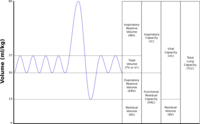
Photo from wikipedia
Background Occupational pesticide exposure is a potential risk for respiratory health effects. Most clinical studies on pesticide exposure were related to acute exposure, and only a few studies on chronic… Click to show full abstract
Background Occupational pesticide exposure is a potential risk for respiratory health effects. Most clinical studies on pesticide exposure were related to acute exposure, and only a few studies on chronic exposure have been conducted. This study investigated the chronic respiratory health status and the chronic effects of occupational pesticide exposures of farmers in Gyeonggi-do. Methods Surveys and pulmonary function tests were conducted on 1,697 farmers in 16 regions of Gyeonggi-do. The structured questionnaire included demographic characteristics, medical history, recent respiratory symptoms and diseases, and work-related conditions, and was conducted through one-on-one interviews. The prevalence of respiratory diseases was compared by the odds ratios (ORs) at 95% confidence intervals (CIs) estimated by logistic regression analysis. Additional multivariate logistic regression analysis was also conducted. Results Pesticide work groups showed significant association with an obstructive pattern in the lung function test (unadjusted OR, 2.38; 95% CI, 1.17–5.52). Selected work-related variables of pesticide exposure were ‘start age,’ ‘cumulative duration,’ ‘mixing pesticides,’ and ‘protection(goggle).’ The obstructive pattern of lung function test showed significant associations with mixing pesticides (OR, 2.30; 95% CI,1.07–5.46), and protection (goggle) use (OR, 0.34; 95% CI, 0.12–0.79). Conclusions Mixing two or more pesticides showed a significant association. Wearing goggles can be seen as an indicator of awareness of the protective equipment and proper wearing of protective equipment, and loss of pulmonary function can be prevented when appropriate protection is worn.
Journal Title: Annals of Occupational and Environmental Medicine
Year Published: 2022
Link to full text (if available)
Share on Social Media: Sign Up to like & get
recommendations!